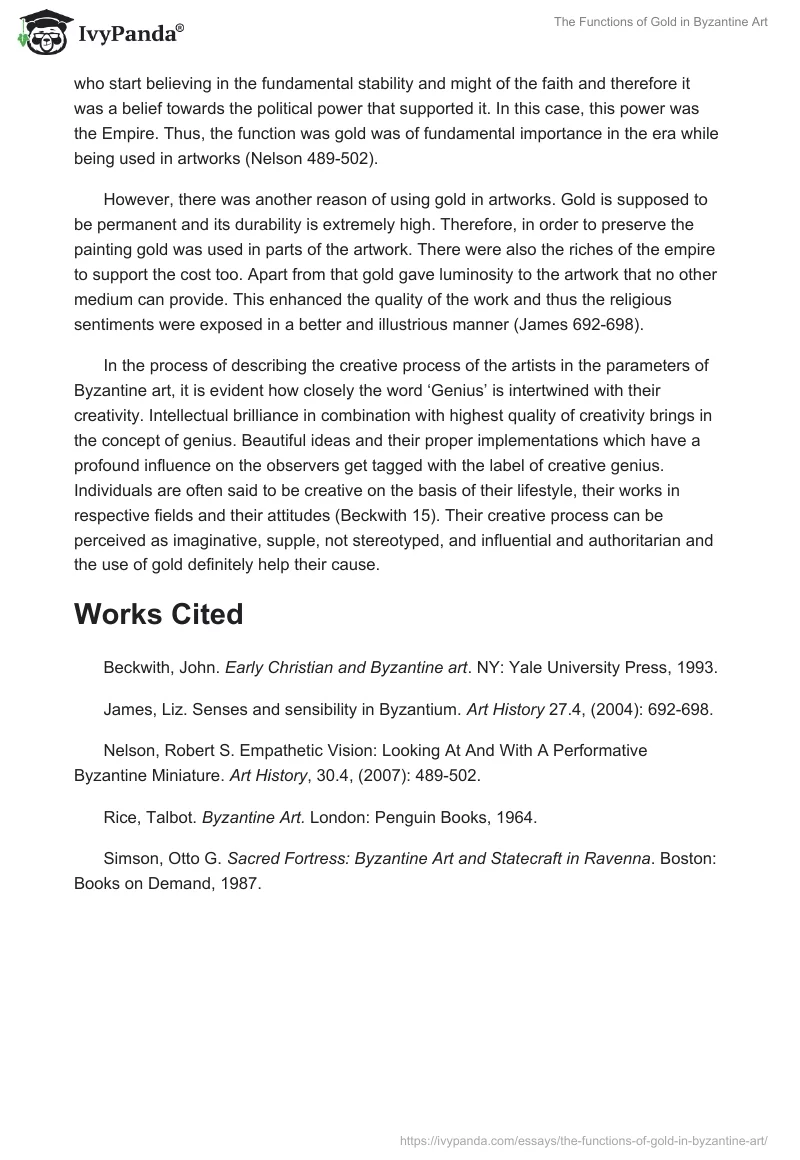Creative process is a psychological and societal process relating to the creation of new innovative ideas or conceptions, or new relations of the creative mind among accessible notions, thoughts or perceptions. The creative process is driven by the development of either conscious or unconscious awareness. A different idea of creativity is that it is purely the process of creating or generating something new and original. In this case the use of gold used in the artwork provided that extra new substance that glorified the religious aspects of the era (Simson 112).
Political and religious leaders in the Holy Roman Empire found a new source of power during the 14th century and this power was religion and faith. The common people of the region was thus influenced with religious art to make them more stable believers of Christianity and it was essential to show the common that this empire was powerful by the dint of its fait. As a result, art became a weapon or tool of extreme propaganda. From the ancient ages, art has always been a free expression.
But now, the perspective changed but it was controlled by the empire and the subject of this control was the general population by use of faith. Thus, to show the value of faith it was necessary to manifest the might of the empire through art. Under such conditions, there was a distinct function in the use of precious metal like gold in the forms of Byzantine art during this era (Rice 27).
Gold is a very precious metal and anyone who is in possession of gold can be considered as powerful. Logically, the empire or political power that is capable using gold in art works dedicated to Christian faith must be a very powerful, thus stable. This was an assurance for the residents of the region.

Any association of gold is a point of power and when, for example, “Icon of the Savior”, (James 692-698) decoration of gold makes it more important to the viewers who start believing in the fundamental stability and might of the faith and therefore it was a belief towards the political power that supported it. In this case, this power was the Empire. Thus, the function was gold was of fundamental importance in the era while being used in artworks (Nelson 489-502).
However, there was another reason of using gold in artworks. Gold is supposed to be permanent and its durability is extremely high. Therefore, in order to preserve the painting gold was used in parts of the artwork. There were also the riches of the empire to support the cost too. Apart from that gold gave luminosity to the artwork that no other medium can provide. This enhanced the quality of the work and thus the religious sentiments were exposed in a better and illustrious manner (James 692-698).
In the process of describing the creative process of the artists in the parameters of Byzantine art, it is evident how closely the word ‘Genius’ is intertwined with their creativity. Intellectual brilliance in combination with highest quality of creativity brings in the concept of genius. Beautiful ideas and their proper implementations which have a profound influence on the observers get tagged with the label of creative genius. Individuals are often said to be creative on the basis of their lifestyle, their works in respective fields and their attitudes (Beckwith 15). Their creative process can be perceived as imaginative, supple, not stereotyped, and influential and authoritarian and the use of gold definitely help their cause.
Works Cited
Beckwith, John. Early Christian and Byzantine art. NY: Yale University Press, 1993.
James, Liz. Senses and sensibility in Byzantium. Art History 27.4, (2004): 692-698.
Nelson, Robert S. Empathetic Vision: Looking At And With A Performative Byzantine Miniature. Art History, 30.4, (2007): 489-502.
Rice, Talbot. Byzantine Art. London: Penguin Books, 1964.
Simson, Otto G. Sacred Fortress: Byzantine Art and Statecraft in Ravenna. Boston: Books on Demand, 1987.


